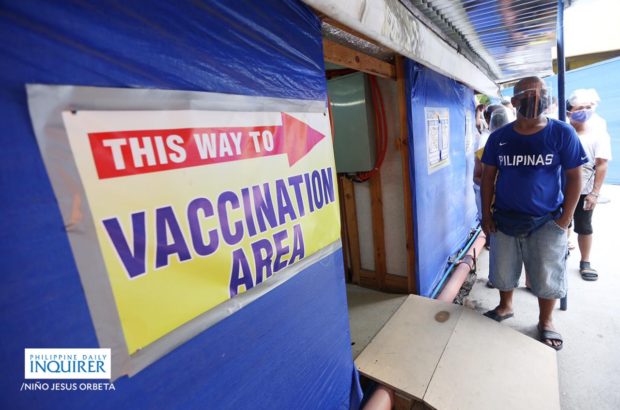Galvez apologizes as Metro Manila runs out of COVID-19 vaccines

Mandaluyong City Mayor Menchie Abalos leads the inoculation of tricycle drivers, vendors and media practitioners belonging to the A4 priority group at Mandaluyong City Medical Center Mega Vaccination Site on Monday, June 7. Niño Jesus Orbeta/Philippine Daily Inquirer
MANILA, Philippines — Several vaccination sites around Metro Manila will be temporarily closed this week after supply ran out.
Vaccination chief implementer Secretary Carlito Galvez Jr. on Wednesday apologized to local governments and promised that Metro Manila would get its fresh allocation starting June 14 as millions of new doses were expected to arrive this week.
Galvez explained that supply in the National Capital Region (NCR) this week was thin because 80 percent of the one million Sinovac doses shipped early this month went to areas outside the so-called NCR Plus 8, which comprises Metro Manila and eight adjacent or highly urbanized provinces.
“I am asking for some patience from the [local governments] as there really was a delay [in the shipment] of the three million (doses) intended for the A4 for June due to logistical challenges,” Galvez said in a radio interview.
He said a global shortage, countries rolling out their own mass vaccinations, and supply chain issues delayed the delivery of the vaccines that were supposed to arrive in the Philippines in May.
Article continues after this advertisement“That three million (doses arriving this week) would fill up (our stockpile) for June. It was just a two-week delay,” Galvez said.
Article continues after this advertisementSerious concern
In the Senate, Minority Leader Franklin Drilon aired serious concerns on the sluggish vaccination program and the big number of people who did not return for their second dose of COVID vaccines.
Drilon noted that only 1.2 million Filipinos have completed doses as of June 2, or “far short” of its target to vaccinate at least 70 million of the population.
“The government must ramp up its vaccination drive and increase its daily vaccination rate. At the rate it is going now, I do not see the light at the end of the tunnel,” he said.
Citing the report submitted by the Inter-Agency Task Force for the Management of Emerging Infectious Diseases (IATF) to the Senate as of June 2, Drilon noted that the number of Filipinos who have completed the required two doses translated to about 30 percent of the total number of vaccinated people, leaving 70 percent who have yet to receive their second dose.
He urged the IATF to intensify its information drive and innovate in order to get people to complete their doses, warning that this could undermine the success of the government’s inoculation program.
He also cited reports that only 20 percent of senior citizens and people with comorbidities were inoculated since the vaccination rollout started in March.
The government had missed its target of inoculating priority sectors as it has vaccinated only 1.3 million out of 9.4 million senior citizens and 1.1 million out of 14.5 million people with comorbidities since the start of the vaccination drive, Drilon said.
Drilon also lamented the World Bank’s downgrading of its Philippine economic growth forecast this year to 4.7 percent from the previous 5.5 percent due to the rising COVID cases and the continued imposition of strict community quarantine.
Supply coming
“The government must remember that our economic recovery depends largely on our ability to inoculate at least 70 percent of our countrymen as effectively and as fast as we can,” he said.
At a vaccine rollout in mall theaters in San Juan City, Galvez reiterated that the country expected 11.06 million jabs this month alone, including the 3.2 million Sinovac and Pfizer doses coming in today (Thursday), considered the biggest single-day vaccine shipment to the Philippines so far. Another 100,000 doses of Sputnik V are scheduled to arrive on Friday.
Earlier, Quezon City Mayor Joy Belmonte noted that the situation has turned from “vaccine hesitancy” to “vaccine envy,” with more people turning up at sites despite the short supply.
“We can view this as a positive development to some extent because it shows increased demand. It may also point to a snowballing or bandwagon effect, in that as more people get vaccinated, more are converted from being hesitant,” according to health systems specialist Dr. Albert Domingo.
But while the government might take advantage of increased demand, Domingo said the main drivers of vaccine acceptance should still be information drives and guidance from experts.
Economic front-liners
Meantime, the inoculation in San Juan City on Tuesday covered the A4 priority list called economic front-liners, or those who needed to be physically present in their workplaces.
The city health department was able to vaccinate 2,500 economic front-liners on the first day of the inoculation of the A4 priority group.
The country’s first case of COVID-19 local transmission was recorded in San Juan on March 6, 2020.
San Juan Mayor Francis Zamora also encouraged business owners and workers in the city to register for the vaccination program, noting that they could also provide incentives to their customers who had been inoculated against the disease.
Under Executive Order No. 82, Zamora encouraged business owners to offer discounts or promos to people who would be able to present their COVID vaccination cards and, in turn, increase foot traffic in their establishments.
The mayor said stickers would be put on doors of establishments whose employees have all been fully vaccinated.
“These are always bundled together—vaccination, economic recovery, privileges, discounts. We need to think of creative ways to reinvigorate the economy and, at the same time, increase the number of people vaccinated,” Zamora said.